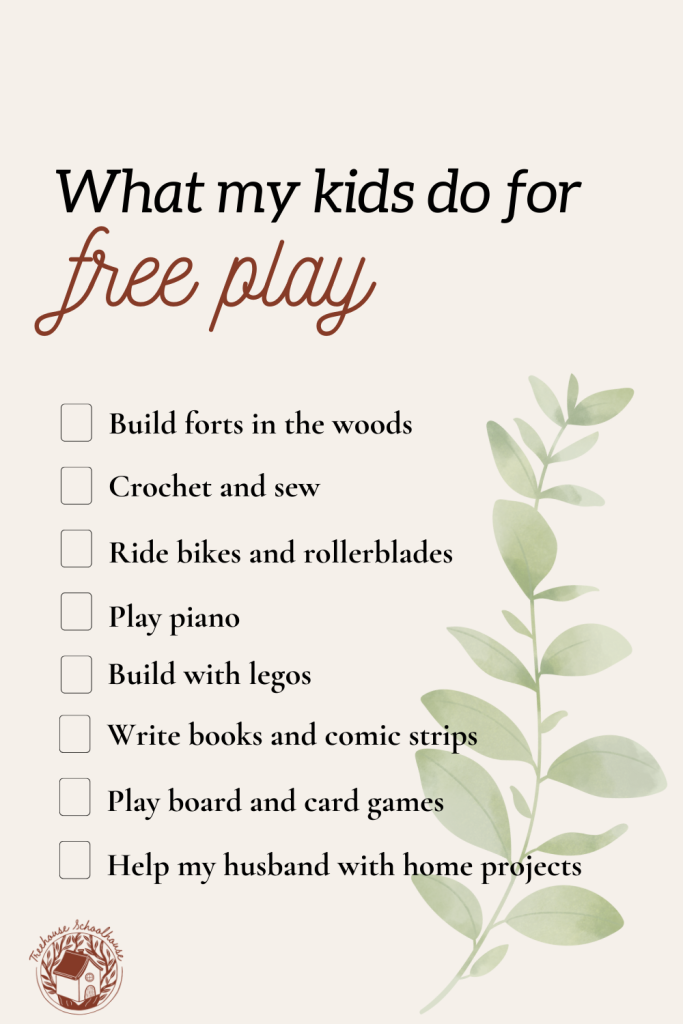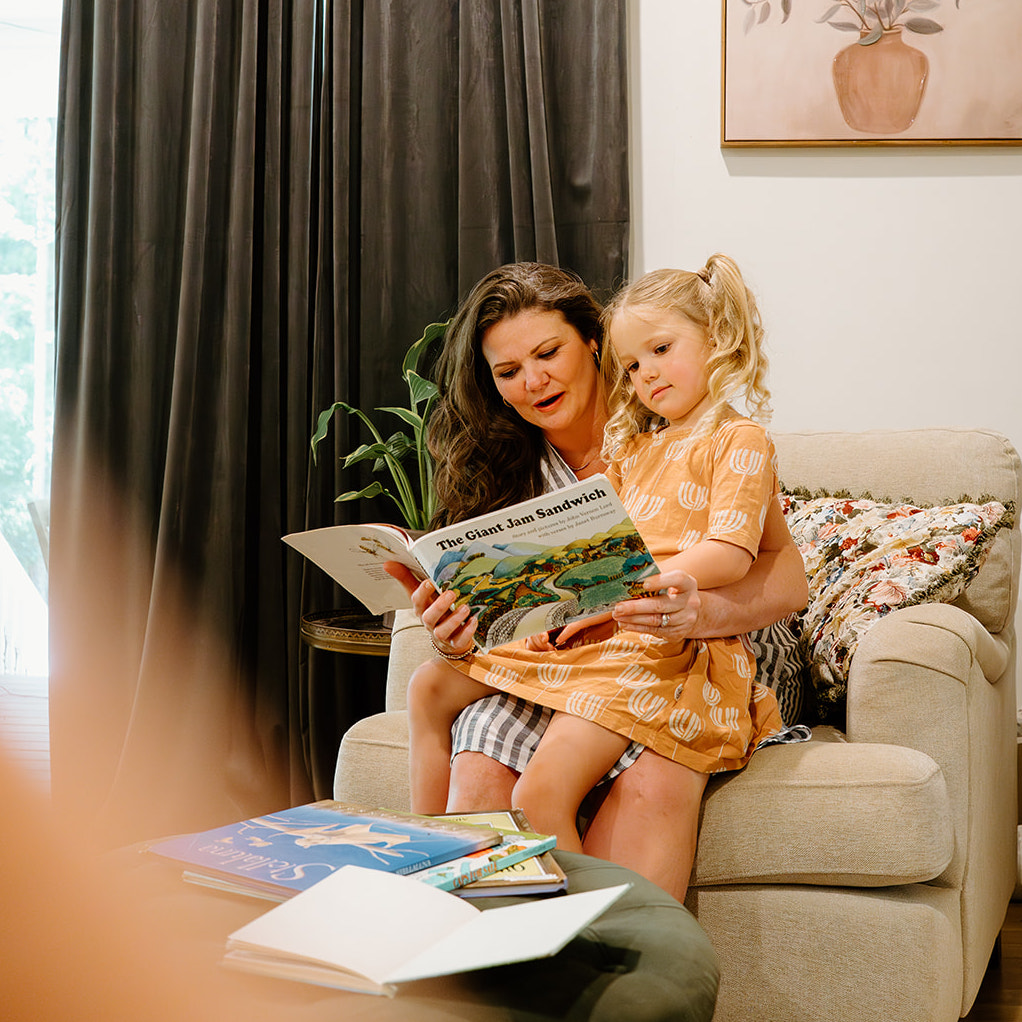“In this time of extraordinary pressure, educational and social, perhaps a mother’s first duty to her children is to secure for them a quiet and growing time, a full six years of passive receptive life, the waking part of it for the most part spent out in the fresh air.” – Charlotte Mason
Giving all of my children ample time in nature is a priority to our family and one of the top reasons we homeschool. Before we begin formal education, one of my main goals for my young ones is for them to gain a huge appetite for lots of unstructured play and exploration in nature. It’s one of the easiest goals to meet, really. Children are designed to love the outdoors!
Time in nature has so many benefits to development and really sets our young ones up for success when they hit those years of formal schooling. Who knew preparing them for school could be as easy as shipping them outside?
Related: Five Intentions for the Early Years
In this blog post:
- Benefits of nature play for children
- Ideas for nature play in the early years
- Nature curriculum from Treehouse Schoolhouse
Benefits of nature play for children
Playing in nature helps develop the habit of attention.
Spending time in nature helps children develop the habit of attention when they study a flower closely or squat down to watch a bug walk along. The habit of slowing down and paying attention to detail is so important and will set them up for success in reading, comprehension, and studying further topics.
Playing in nature gives space for creativity.
Without the rules of material objects, toys, and walls, children can often think more creatively in their play outdoors. Using various nature elements, they can design their own activities and approach play in fresh ways.
Playing in nature provides endless opportunities for sensory experiences.
Forget the expensive and messy indoors sensory bins (I know, there is a time and a place for this). Put your child in a pile of sand or gravel and watch them immerse themselves in sensory play. Sensory play is another outlet for creativity and helps the development of fine motor skills (what is needed for holding a pencil later!).
Playing in nature calms children through engaging the senses.
Nature provides a richer life experience than what toys and screens do. Nature may seem less stimulating than a toy that makes noise and lights up, but it actually engages more senses. In the outdoors, you can see, hear, smell, and touch the environment. Our bodies were designed to feel a sense of calm when we hear the wind rustle trees, smell a wildflower’s sweet scent, or watch a stream trickle over rocks.
Playing in nature improves coordination, balance, and gross motor skills.
As children interact with different outdoor natural resources like fallen logs, rocks, and mud, it gives them opportunities to strengthen their coordination, balance, and gross motor skills. This is different from unnatural materials because they are more predictable.
Ideas for nature play in the early years
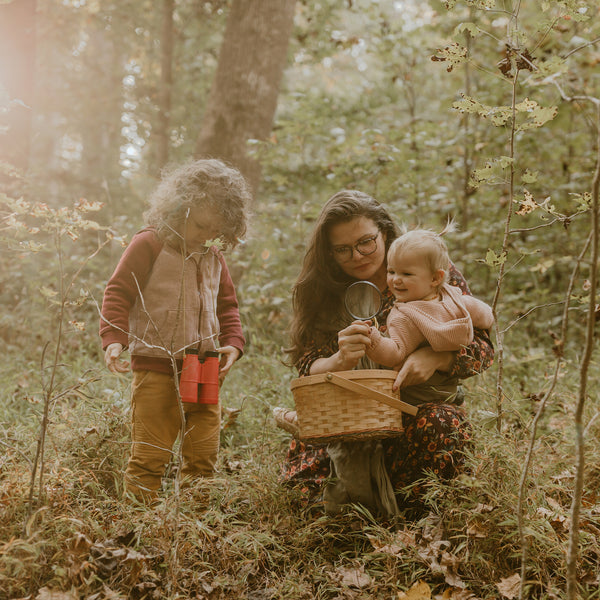
I have found that having a safe outdoor space for the little ones to go out without me right there with them, but within my sight/ hearing range, is essential. It doesn’t have to be fancy or large, but somewhere safe that they can get that unstructured play in while I finish the dishes or read aloud to my older children has been perfect. Our current outdoor space is right outside our back door. They spend most of their outdoors hours in this little space and find plenty to do!
Before I had older children to complete homeschool lessons with, I took my preschool-aged children out and about every day to parks, trails, creeks, etc. If you are in that season, I highly encourage you to take advantage of that. Now, we do those outings, but not as often. We also spend around 4-6 hours outside every Friday with our Wild + Free homeschool community group and as much time as possible on the weekends, going on hikes or more time in the yard!
Related: Our Homeschool Preschool Daily Rhythm
Here are 30+ nature play ideas for the early years (most would also appeal to older children as well!) Most can happen in your own backyard, and some you may need to find a different location to explore.
- Make mud pies: Give them some empty pie pans and encourage them to find small stones, sticks, and other natural elements to decorate their pies.
- Find pictures in the clouds: Lay back on the grass and try to spot figures in the clouds.
- Make a fairy garden: Keep it as simple or involved as you want with only natural elements or by offering little accessories like gems and stone fairies/ gnomes to add. We like doing this up against a tree trunk or in a flower pot.
- Pick flowers and weeds: Give your child a little cup or vase and ask them to make you a bouquet of anything they find delightful to display on your table or windowsill.
- Draw pictures in the dirt: Write letters or draw pictures in the dirt with sticks.
- Go on a bug hunt: Go on a hunt to find all sorts of crawly creatures under logs or on tree trunks. We love using this little bug catcher to observe our findings for a few hours.
- Balance on fallen logs: This is such a great activity for balance and coordination. It’s even more fun to throw a log over a small stream or creek and walk across.
- Make a stick fort: Lean long sticks up against a tree or in a tee-tee shape and you have a fort to play in for hours! We have been known to make and keep these up for weeks in our own forest beyond our home and in forests all around our area. It’s especially fun to go back to a favorite location and visit your fort later.
- Go on a nature scavenger hunt: Make a list of items that would be easily found in your surroundings and have your children go on a hunt!
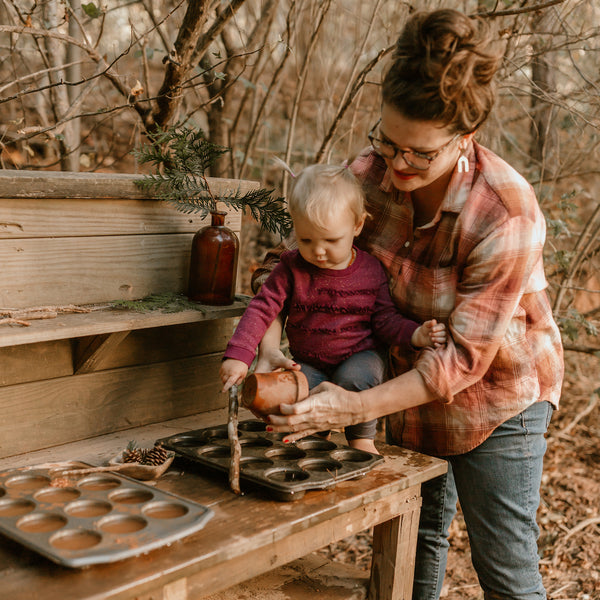
- Play in a mud kitchen: Our #1 favorite backyard structure is our mud kitchen. Add some old pots, pans, and utensils. My kids especially love having a muffin pan to make all sorts of treats.
- Climb trees: Climbing trees is great for calculated risk-taking, balance, and problem-solving.
- Draw in a nature journal: Give your child a sketch book and some drawing utensils and encourage them to focus on one element of nature to draw. Take it to the next step and identify and label what it is in a field guide or nature encyclopedia.
- “Wash” things with water: A simple bucket of water and a sponge goes a long way! My kids also love spraying trees or the mud kitchen with water-filled spray bottles and scrubbing them down. They also enjoy washing rocks, acorns, and other natural elements with an old toothbrush.
- Balance rocks: Make a tower by balancing rocks. This is easiest with smooth stones and stacking largest to smallest.
- Listen and watch for birds: We love looking up into the trees and looking for and identifying various birds in our backyard. Looking for nests is also a fun activity. Use a field guide to help you identify what the common birds are in your area.
- Play hide-n-seek: This classic game is even more exciting behind trees and shrubs.
- Build a maze with sticks: If you have an open area on the ground, make a maze by laying sticks on the ground like a path for your children to walk through to get to the end.
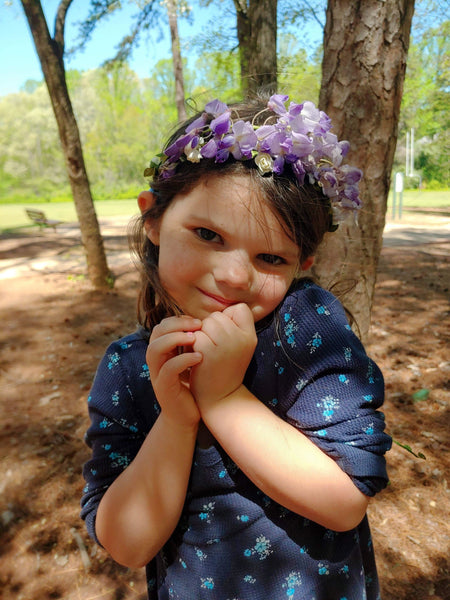
- Make a nature crown: There are many ways to do this- some more complicated than others. Search online for a simple tutorial and teach your children the basics so they can explore this idea on their own.
- Build sand or dirt castles: We have a sandbox that gets hours of play each day, but even if you only have dirt- your children can build castles and decorate them with rocks, shells, or whatever they can find.
- Make leaf rubbings: Find some flat leaves and do a rubbing by laying the leaves on a flat surface, covering with white paper, and coloring on top of them lightly with crayon.
- Dig for worms: Kids love hunting for worms and watching them wiggle. Make a wormery to observe them for a longer period of time.
- Create a rock shop: It’s such fun to collect and wash up some rocks and then set up a little rock shop for others to “buy” the rocks. Maybe the payment is acorns or leaves!
- Gather leaves and jump into them: Whether your children have a little rake or not, they can gather leaves and have all sorts of fun jumping, rolling and throwing them all about.
Related: Sunflower Dissection Activity for Kids [Free Unit Study]
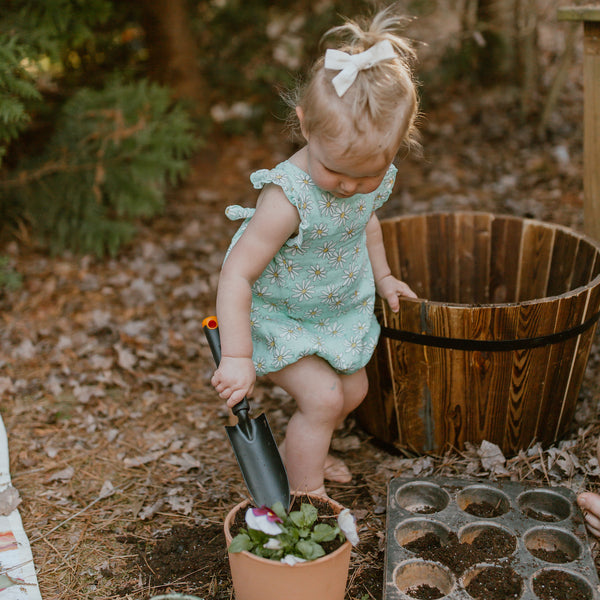
- Grow and tend to something: Plant some simple herbs or go as involved as a huge garden and involve your child in the watering, weeding, and harvesting.
- Go on a nature walk: Go with a completely open plan or something specific to hunt for. Some of our favorites are an animal track hunt, birds, or collecting a specific element of nature like pine cones or seeds.
- Collect and sort natural elements: This is an excellent learning opportunity for young ones. Collect a variety of natural elements and then sort them by size, color, or shape.
- Play a make-believe game: My children love acting out their favorite stories in the woods or in the backyard. Read a story set in nature and then give them a few ideas to start and see where it takes them. Read more about play-based narration in this post: Five Intentions for the Early Years.
- Make leaf glitter: Collect fallen leaves and use scissors to cut or fingers to rip them up into little pieces to create leaf glitter or confetti. Use it to throw in the air for fun or for a craft project.
- “Paint” with mud: Give your children an old paintbrush and a bucket of mud to paint trees, logs, or anything else they can find.
- Go on a senses hunt: On a nature walk or in the backyard, tune your children’s senses in to discover the natural world around them. We like to draw what we see, hear, smell, feel, and if we’re lucky enough to find something edible- taste!
- Build a nest: Use grass, mud, and leaves to make a bird’s nest. Leave it in a tree and watch it over time to see if any feathered friends enjoy it.
- Hide and find treasures in sand: This is another great sandbox activity. Give your child little gems or encourage them to hunt for acorns or something else to hide for you or another child to find!
These ideas only brush the surface of the ways children can play in the great outdoors. I hope this list inspires you to give your children the gift of a life lived outside!
Related: Using Treehouse Nature Study for Pre-K to Kindergarten
Nature curriculum from Treehouse Schoolhouse
If you are looking for ways to intentionally learn with your children this summer, you will love Treehouse Nature Study. Treehouse Nature Study is a year-long seasonal nature study curriculum designed with family-style learning in mind. It is a gentle guide meant to invite various ages to connect with each other and the world around them through living books, nature notebooking, hands-on projects, and beauty subjects such as poetry, picture study, and folk songs. Available in both Primary and Intermediate Years, Treehouse Nature Study will provide years of rich education for the whole family.
Treehouse Nature Study, Primary Years
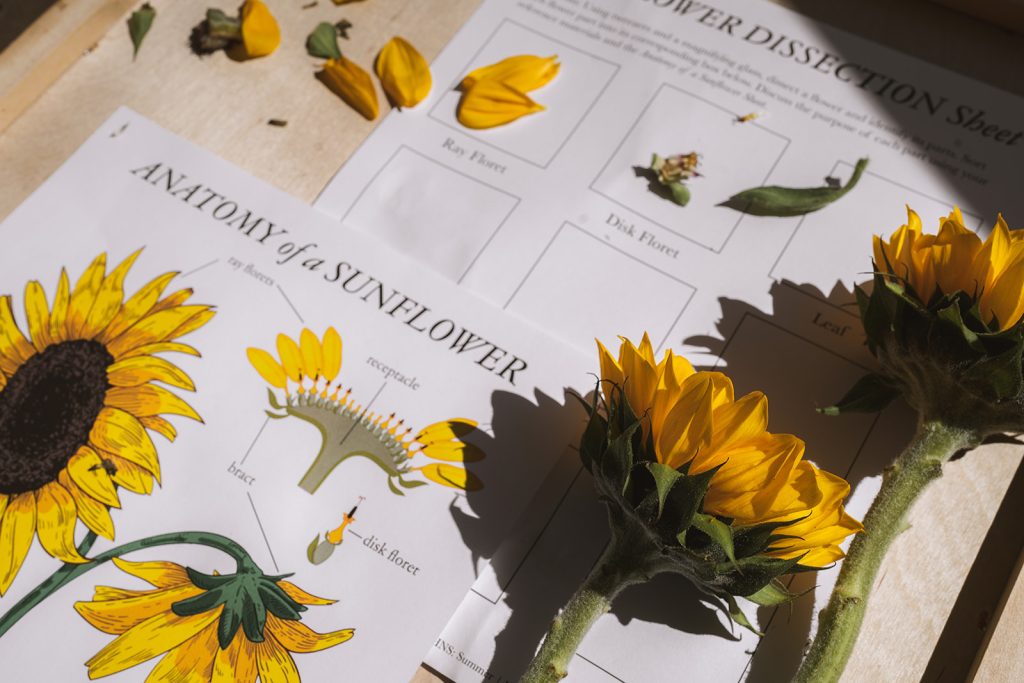
Treehouse Nature Study, Primary Years is a seasonal nature study curriculum designed with family-style learning in mind. It is a gentle guide meant to invite various ages to connect with each other and the world around them through living books, nature notebooking, hands-on projects, and beauty subjects such as poetry, picture study, and folk songs.
From preschool through upper middle school, it appeals to every age and is easily used with multiple ages at the same time.
It would be a great fit for your preschool or kindergartener’s core curriculum or your whole family’s home education Morning Time and Nature Study. It also provides supplemental work for your children’s language arts through poetry memorization, recitation, copywork, and notebooking.
Related: Six Core Values of Treehouse Nature Study
Treehouse Nature Study, Intermediate Years
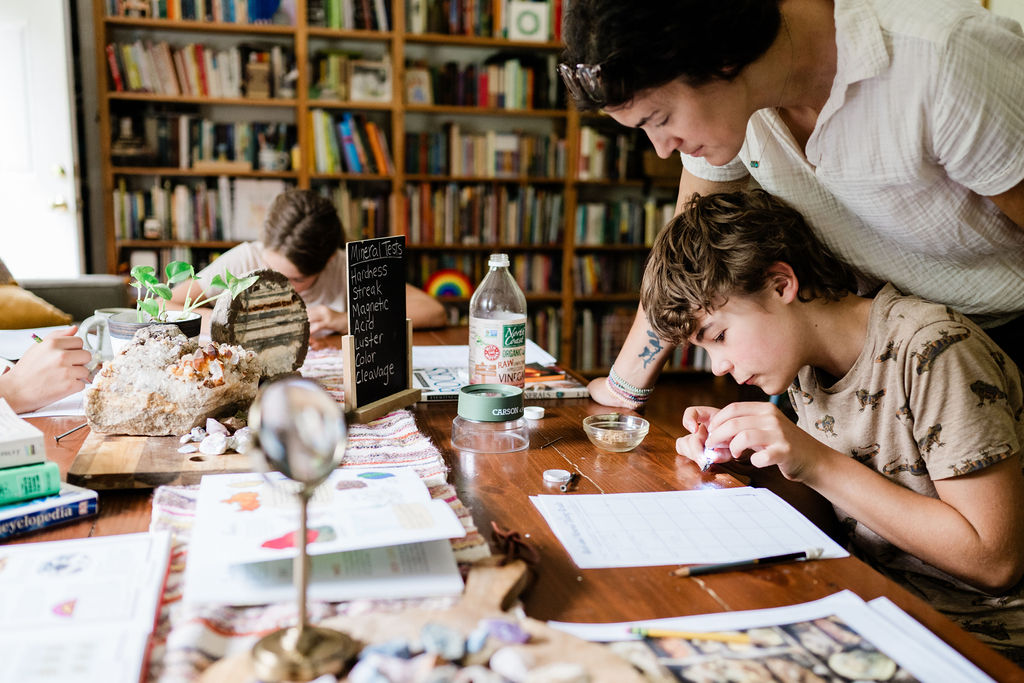
Introducing Treehouse Nature Study, Intermediate Years geared towards grades 4th-8th. Experience a seasonal study that invites your older children to connect with each other and the world around them through living books, nature notebooking, hands-on projects, poetry, and picture study. Deepen your child’s learning through advanced language arts and scientific experiments.
It would be a great fit for your upper elementary or middle schooler’s science curriculum or your whole family’s home education Morning Time and Nature Study. It also provides supplemental work for your children’s language arts through poetry copywork, creating an Illustrated Science Dictionary, creative writing prompts, notebooking, and internet research.
Related: Overview: Treehouse Nature Study, Intermediate Years
